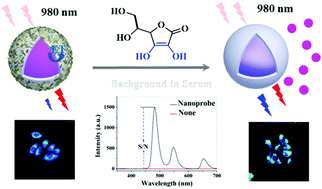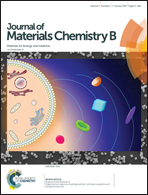A ratiometric nanoprobe consisting of up-conversion nanoparticles functionalized with cobalt oxyhydroxide for detecting and imaging ascorbic acid†
Abstract
The ability to rapidly, sensitively, and selectively detect ascorbic acid (AA) is important for medical assays and diagnoses. Here, a new cobalt oxyhydroxide (CoOOH)-functionalized up-conversion nanoparticle (UCNP) system was designed for the detection of AA. For the UCNPs, ligand-free β-NaYF4:Gd/Yb/Tm/Ho@NaYF4 offered simultaneous blue and red light emission, but CoOOH on the UCNP surface acted as a quencher that could effectively absorb the 475 nm-wavelength light produced by the luminescence of the nanoparticles. This quenching was found to be easily eliminated by the addition of AA through the FRET process. The ratio of the intensity of the up-conversion luminescence at 475 nm to that at 654 nm showed an excellent linear correlation with the concentration of AA. The nanoprobe also exhibited excellent accuracy in the quantitative analysis of AA in diluted fetal bovine serum. In addition, the probe showed an ability to be used for imaging AA in living cells, and may thus be considered as a good candidate for use in clinical diagnosis and drug screening.



 Please wait while we load your content...
Please wait while we load your content...